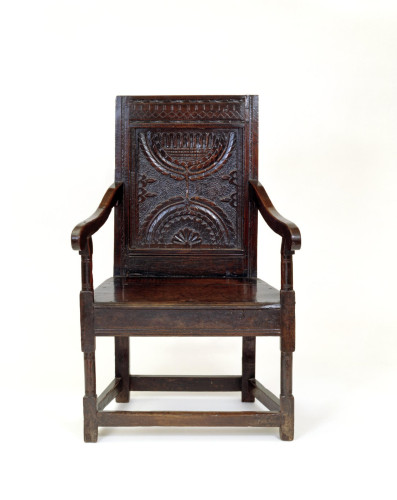51/1992
Collection
Furniture
Brief description
Joined oak elbow chair with a carved back panel with opposed lunettes, made in England c.1620.
Object name
chair
armchair
armchair
Object number
51/1992
Production date
c.1620 (manufactured)
Production place
England (manufactured)
Period
Stuart (1603-1714)
Material
oak
deal
deal
Technique
joined
carved
turned
applied
punched
moulded
tenoned
carved
turned
applied
punched
moulded
tenoned
Physical description
Joined oak armchair with a carved and nulled back panel. The panelled back is carved with two large opposed lunettes on a sunken punched ground within a moulded and channelled frame, between down-curved arms on turned supports. The boarded seat rests on channelled rails raised on pillar forelegs joined by plain stretchers. The lunettes are decorated with stylised foliage. The top lunette is infilled with waill design and nulled arcading, while the bottom lunette has a stylised flower motif. There are two fleurs de lys on either side of the back panel. Above and on the side members of the panel, there is incised decoration, including a diagonal checker band at the top. The chair is stamped 'B' on the right hand front of the top rail, and has been strengthened under the seat.
Dimensions
Height: 104cm
Width: 66cm
Depth: 39cm
Width: 66cm
Depth: 39cm
Website keywords
seating
Label
Label text, Geffrye Museum, date unknown:
Chair, c1620 with carved back panel, joined oak.
Label text for the exhibition At Home with the World, Geffrye Museum (20 March 2012- 9 September 2012):
Armchair
Oak
Made in the west of England, 1600–40
This chair shows an assortment of different influences. Some parts are inspired by architecture; the legs are carved to look like simple columns, and scrolls decorate the top of the chair back. They refer back to the architecture of Ancient Greece and Rome, and furniture made at this time was influenced by the renewed interest in classical civilizations which happened during the Renaissance.
Chair, c1620 with carved back panel, joined oak.
Label text for the exhibition At Home with the World, Geffrye Museum (20 March 2012- 9 September 2012):
Armchair
Oak
Made in the west of England, 1600–40
This chair shows an assortment of different influences. Some parts are inspired by architecture; the legs are carved to look like simple columns, and scrolls decorate the top of the chair back. They refer back to the architecture of Ancient Greece and Rome, and furniture made at this time was influenced by the renewed interest in classical civilizations which happened during the Renaissance.




